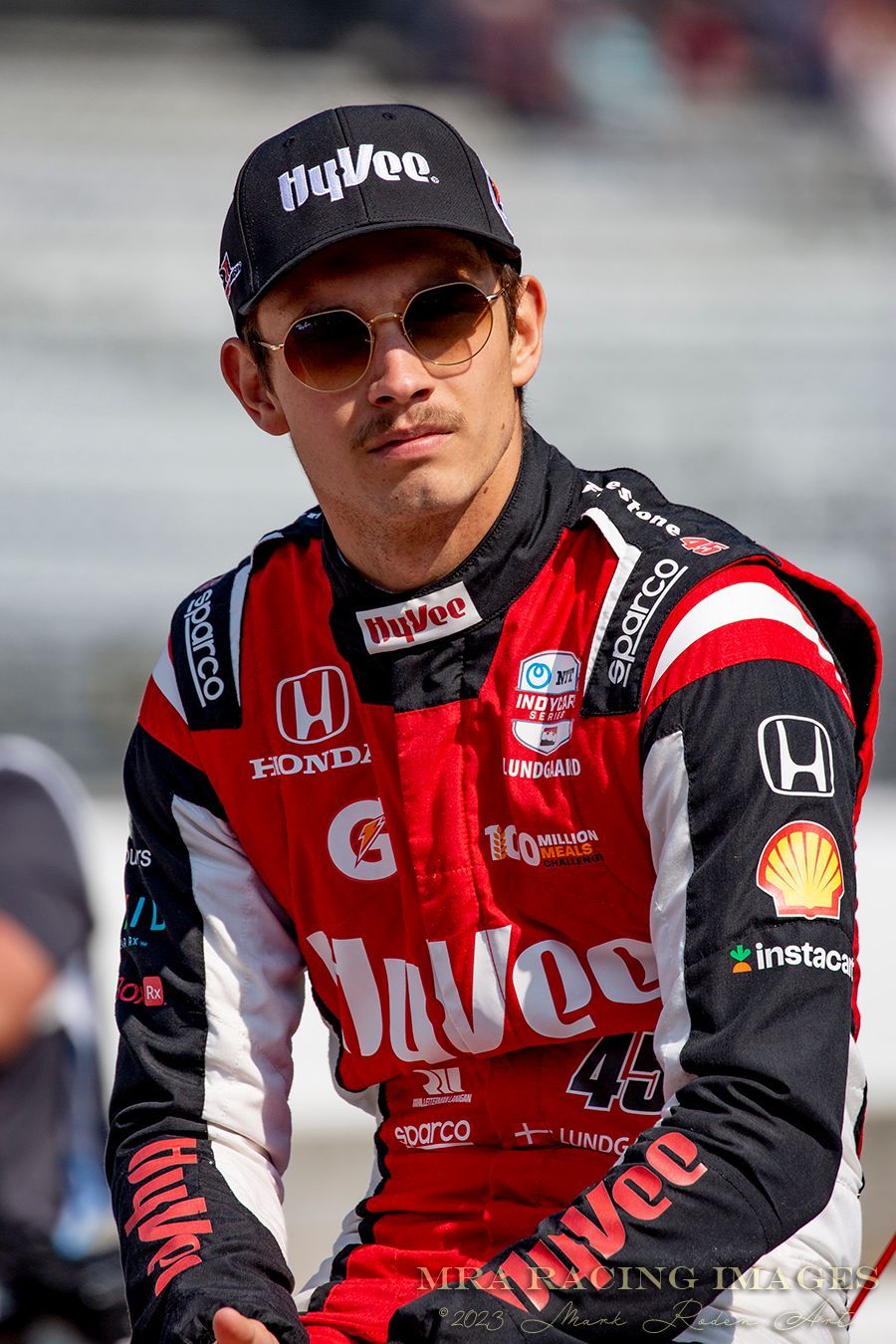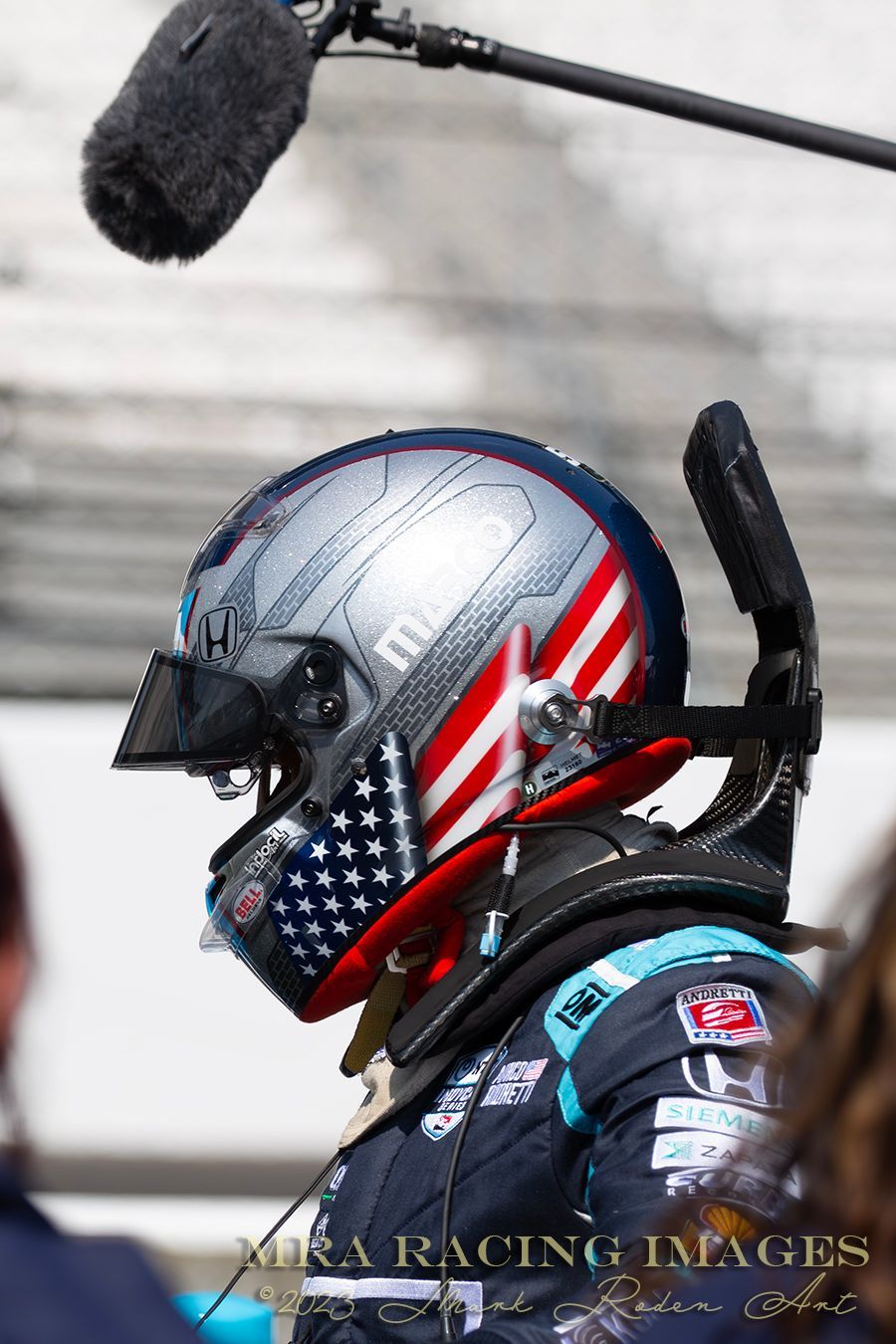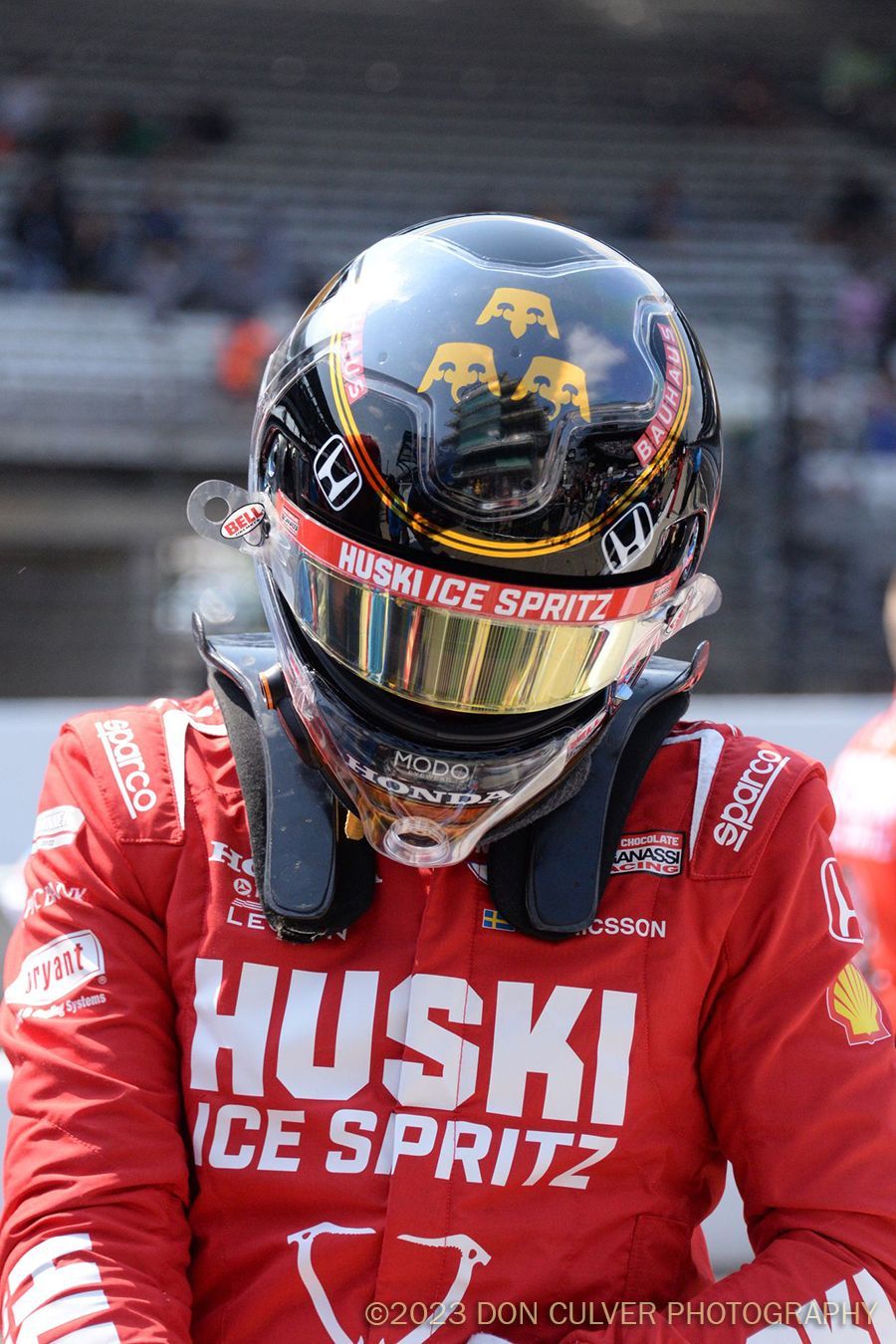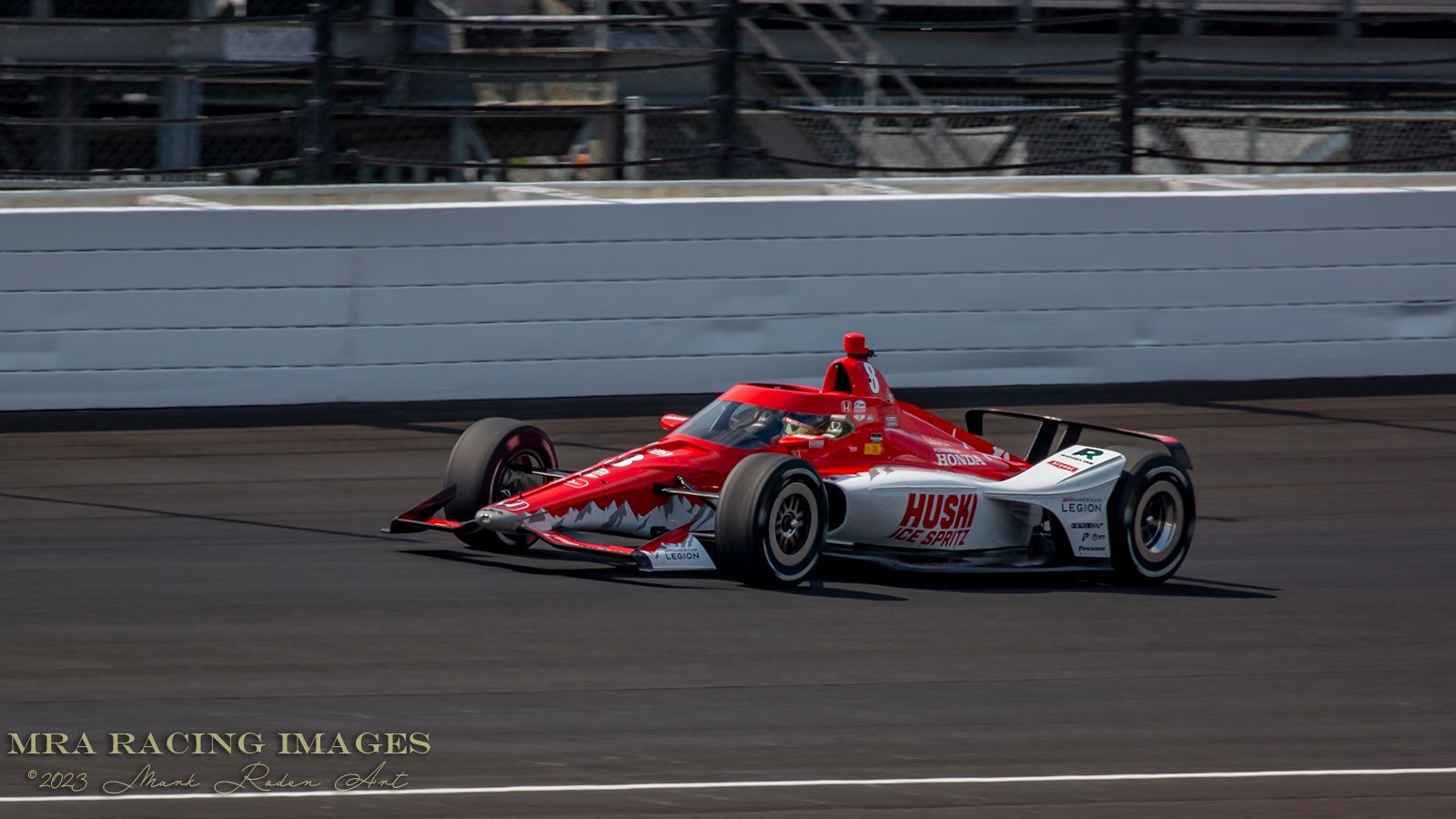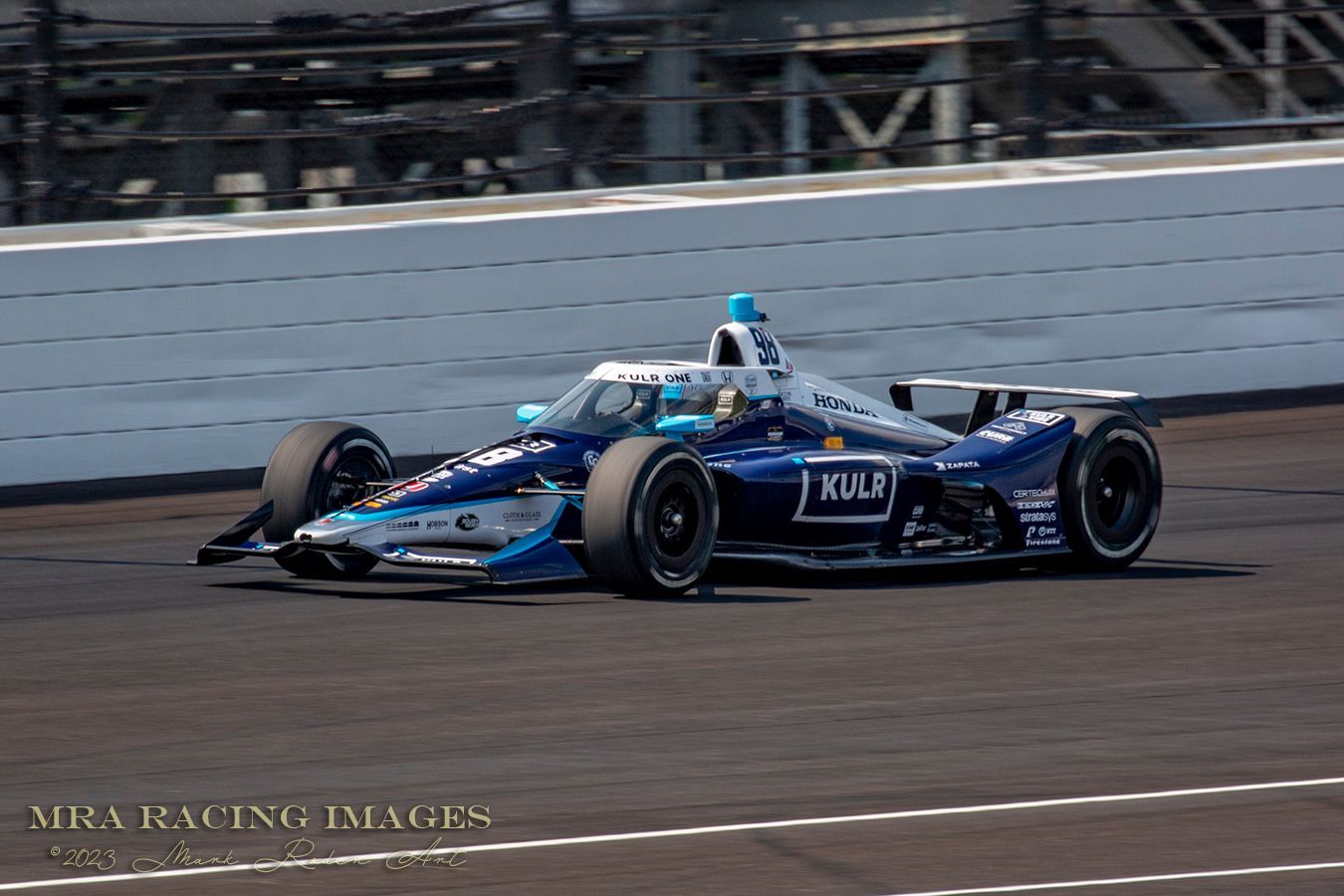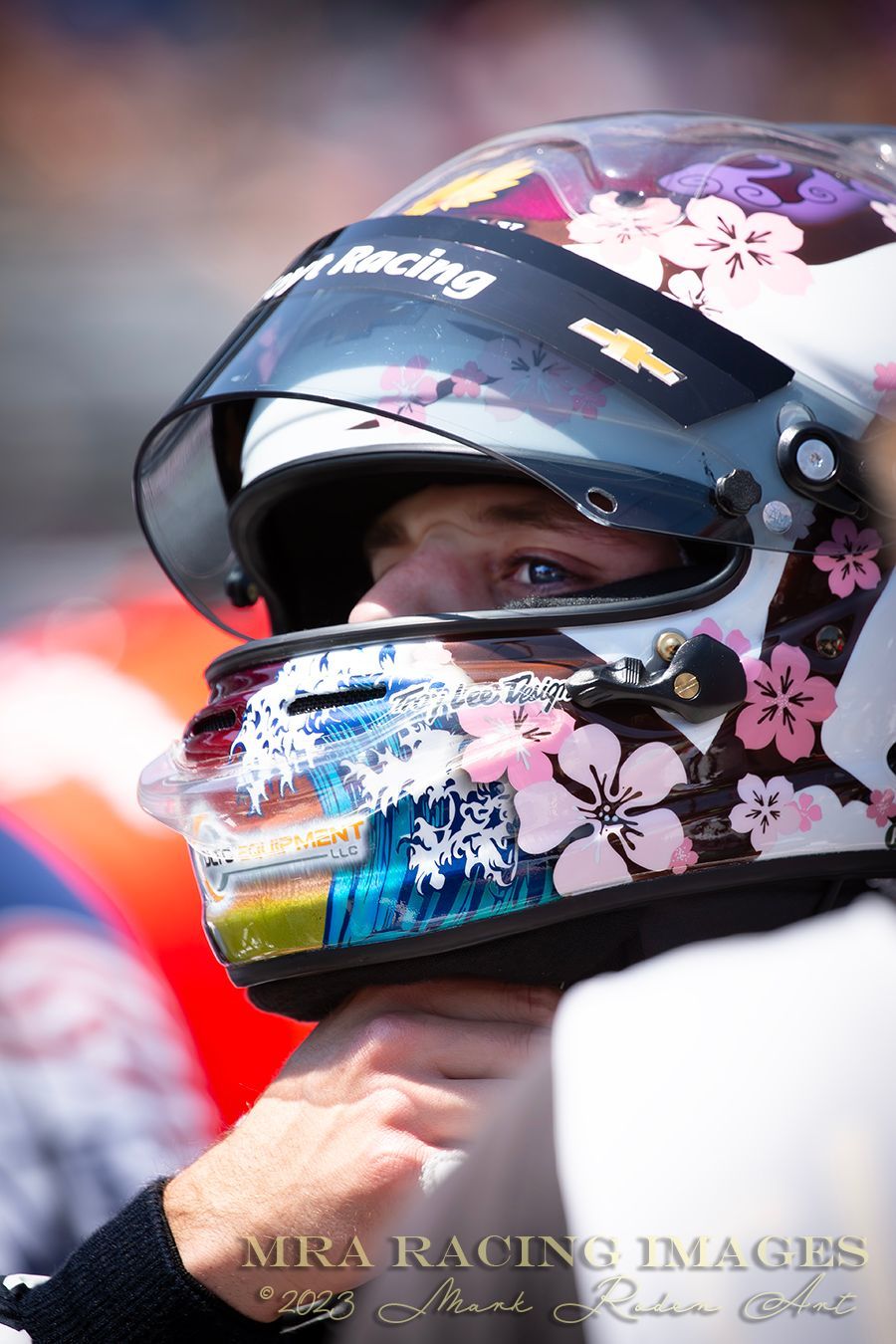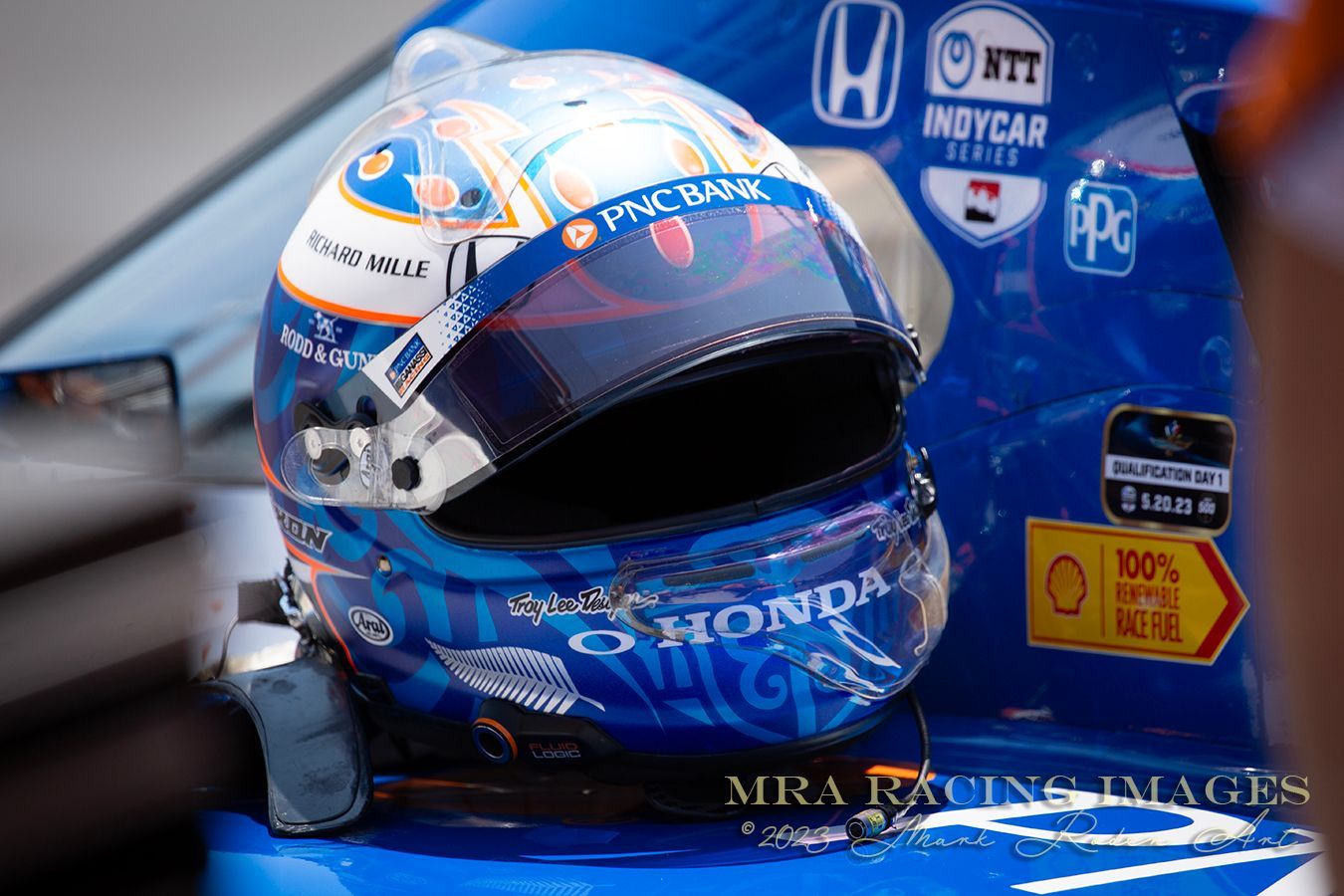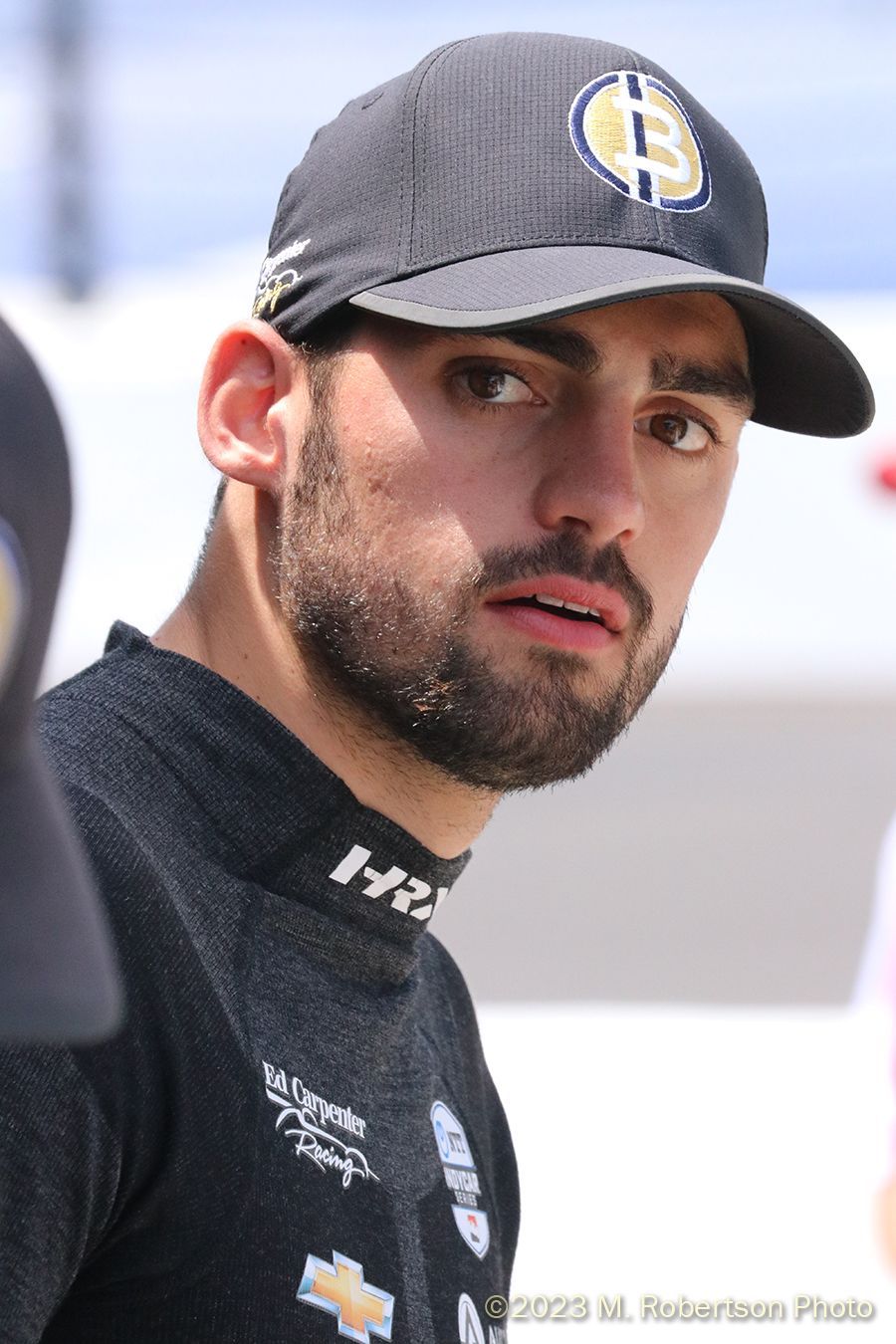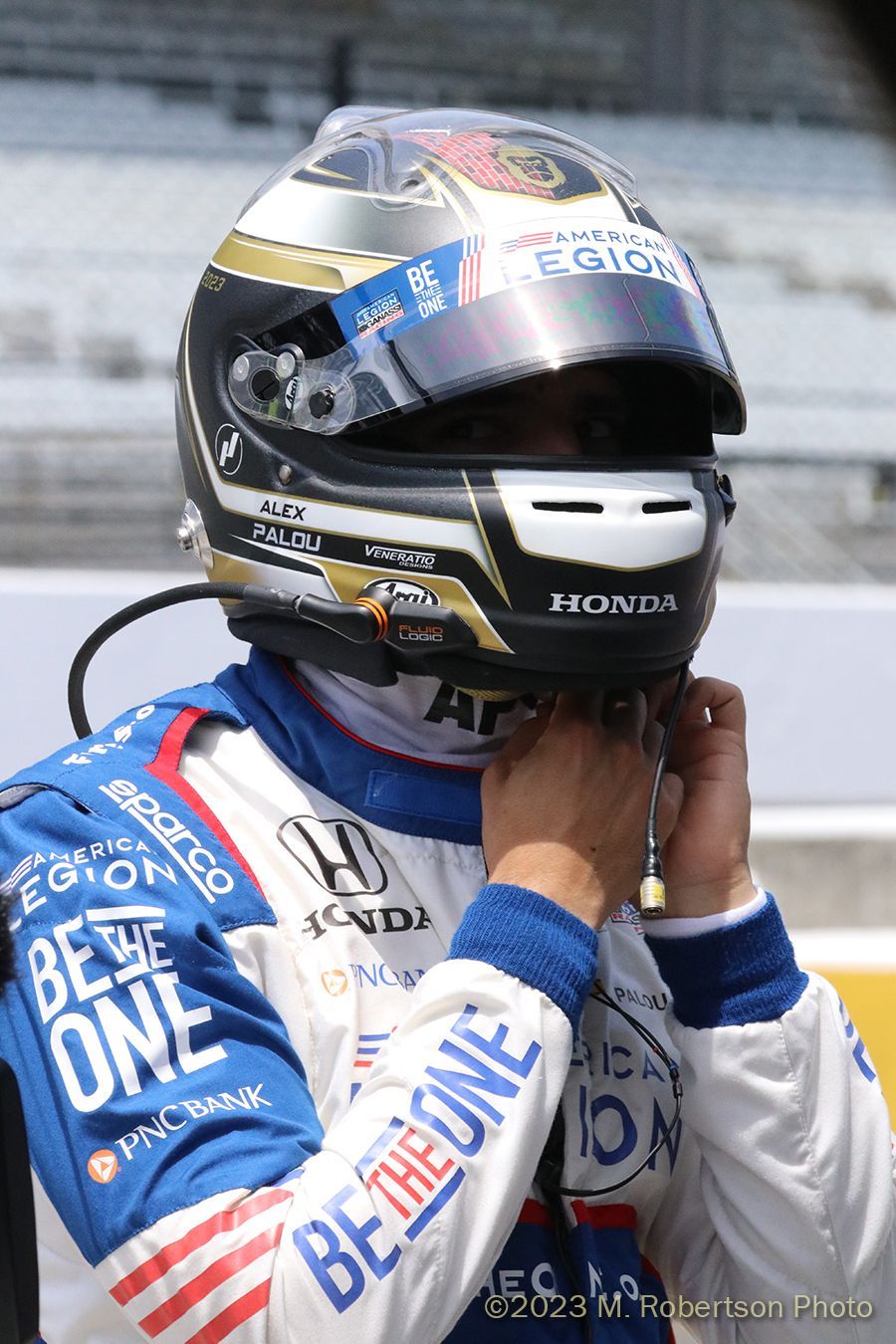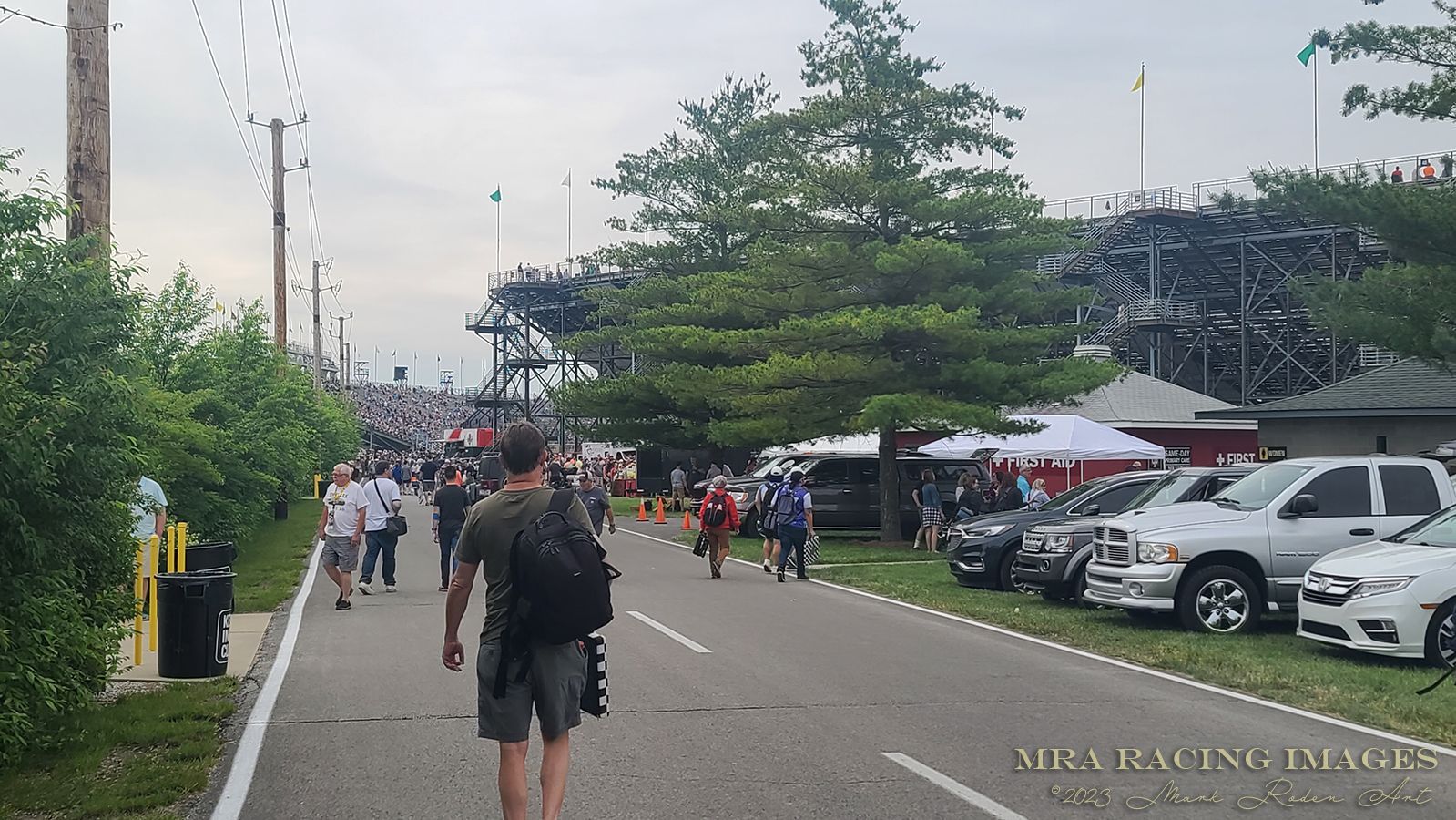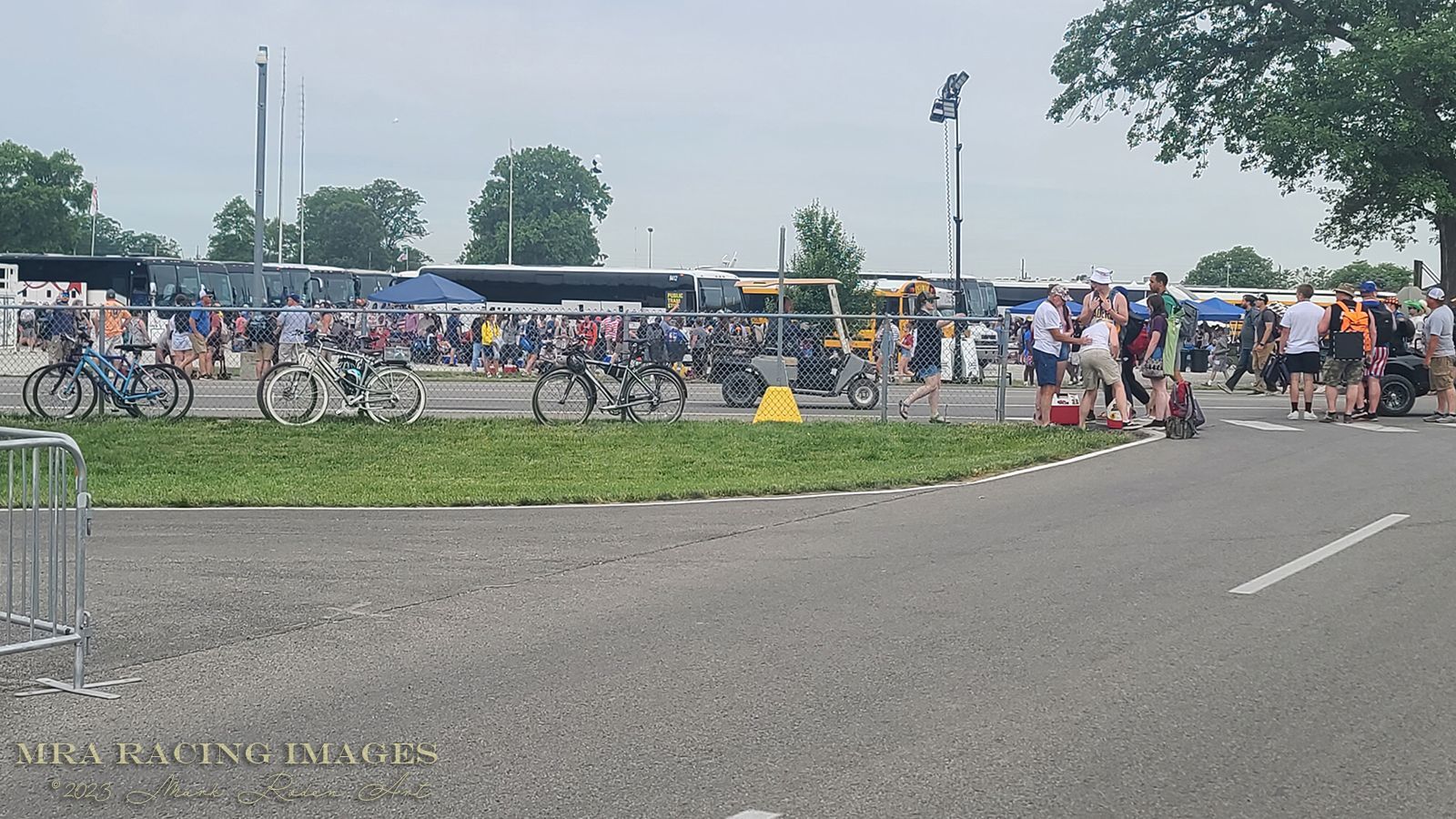2023 Indianapolis 500 Qualifying and Race Day - A Trackside Report by Mark Roden
Special Photography Sections by Mark Robertson and Don Culver
Image Editing Assistance by Joana Esteves of JoMar Visions
20 May, Saturday: Indy 500 Qualifying, Day 1
FP6: 8:30AM-9:30AM EST PRACTICE-FULL FIELD
Q1: 11:00AM-5:50PM EST FULL FIELD QUALIFYING
After a week of practice, it’s finally time for qualifying. Some teams have found their combination, others found the “struggle bus”. Everyone had one last chance to get it right before the track was shut down for qualifications prep. Out of the ten cars participating in this last free practice session, Tony Kanaan put up the big number with a 38.622s lap time and a speed of 233.02mph. Conor Daly also shined at P7, and Callum Ilott of Juncos Hollinger Racing pulled a P9 in the #77.
I arrived around 10AM, going about my usual routine of catching a cart to get through the tunnel and up into Pagoda Plaza, then walking to the entrance of pit road. I had my kit out and ready prior to walking in and managed to catch a few good images of Christian Lundgaard sitting on the wall before his run. Lundgaard is a driver who, in years past, I have never managed to catch in front of my lens. This year he’s everywhere.
I don’t often try to get to the front of the line for qualifications, mainly for the fact that it is so incredibly crowded in that area that it is difficult to see much, as a photographer anyway.
I have found in years past, and again this year, that staying around the cars that are 4-5 slots back is sort of a sweet spot to see the drivers. You have a better chance of catching them walking up to their cars (many times from our side of the wall), hanging around for a few minutes with their team and friends, and even doing interviews before donning their helmet.
As qualifying begins, every driver is guaranteed one run, and they go based on the qualifying order determined by the draw the previous evening. You can read more about the Indianapolis 500 Qualifying Procedure and the 2023 Draw by following this link.
I made the choice to stay with the position near the front of the line a few cars back, photographing the moments before getting into the car. Sometimes, this can produce great results. Other times, I wish I was somewhere else. I find that it’s hit or miss, but I also know that once I make the choice, I need to stay with it; otherwise, it ends up being a lot of walking for nothing.
The end of the qualifying run will have the driver pull in well down pit road, toward the northern pit entrance, and if they have made a successful first qualifying run, they will get the crew in place around the car for a nice set up shot. These are great to have, and it is a good place to get candid shots.

Credit ©2023 M. Robertson Photo
Mark Robertson is a published photographer and photojournalist covering the Indianapolis 500 and US Nationals for Associated Press in the mid- to late-80’s; he published work in Automobile Magazine for Blackburn/Daly. For the last ten years he has been freelance covering Indycar and NHRA drag races across the United States.
Don Culver is a racing photographer with experience going back to 1964. He started with Indy Car and NASCAR and expanded his reach to USAC Sprint cars and Limited sports cars, primarily in the golden age of Can Am. Over the years, he has photographed NHRA, IMSA. WEC, and World of Outlaws Sprint and Late Model races.
I met Don a few years ago through an online Indianapolis 500 fan group, and then later at the race. This year he was able to photograph inside the pit road area using his access to a grandstand suite which also came with a qualification day silver badge.
Don contributes to this report with the following images:
Credit ©2023 Don Culver Photography
Through the remainder of the guaranteed runs, I spent my time at the northern end of Pit Road Terrace, close to the pagoda tower and scoring pylon. I spent a little more time shooting the art project and captured some good qualifying shots as well.
Mark was finishing up in the pits, so we headed off to Stand E outside turn 1 before it got too late in the day. First, we took a short pause inside turn 4 to check out the view for the road course, and then hopped another cart to what has become our favorite afternoon perch at IMS.
The rest of the afternoon was a festival of speed and drama down to the last minute. We had a nice view of the pit road staging area, and a great line of sight view back to turn 4 exit.
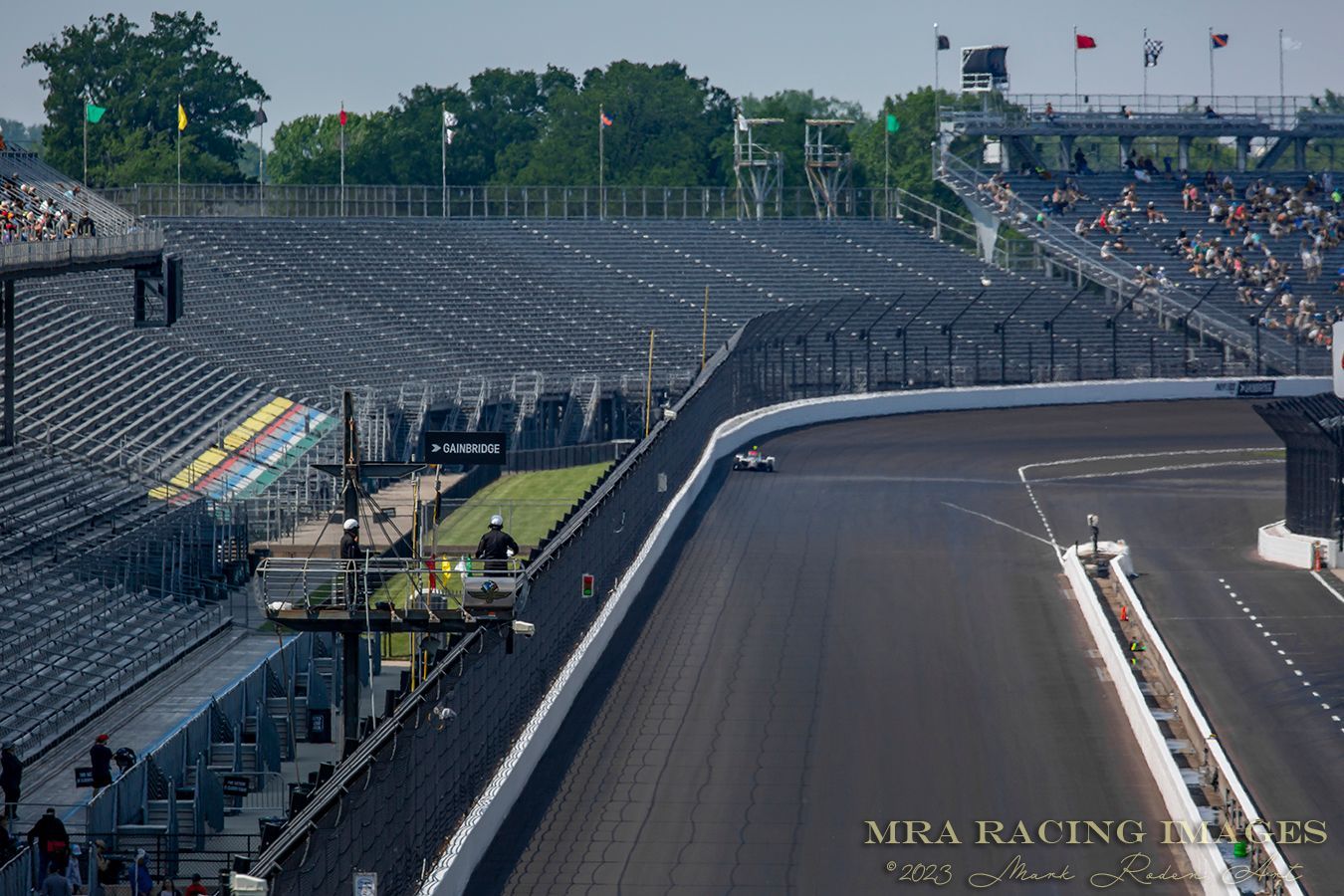
My first shot from our high perch was one of David Malukas, a driver that I always keep a watch on because he can find himself in the mix at a moment’s notice during a race. There was roughly an hour and a half left to qualify for day 1, coming up on happy hour, so everyone was trying to decide which lane to be in.

Some notable efforts out of the guaranteed runs:
- Alexander Rossi turned a 233.528mph 4-lap average, 5th fastest in Indy 500 qualifying history.
- Rinus Veekay knocked out a 233.395mph, 2nd to Rossi’s.
- Pato O’Ward also turned in a nice run at 233.252mph.
- Alex Palou edged out Veekay’s run at 233.398mph; .008s difference in time (or about two field bunnies’ worth of track length).
Subsequent attempts were met with mixed success leading up to the end of the day:
- McLaughlin and Newgarden elected not to take their guaranteed time trial with the initial group. Later, they qualified at 232.503mph and 232.542mph respectively.
- Helio Castroneves compared his second run to a “Kenny G vibe” after a first run which he said was more like “Guns N’ Roses.” This guy.
- Several drivers’ subsequent attempts were waved off, including Ericsson, Pagenaud and Rahal. Will Power made another attempt and improved from 17th to 11th and into the top 12.
- Callum Ilott’s first attempt put him in last (34th) position, but a second run saw him improve to 27th and “off the bubble.”
- David Malukas made a second attempt after Ilott knocked him down to 31st (only positions 10-30 to be decided today) from the priority lane which wiped out his previous attempt. It was waved off after 3 laps, and so he was taken off the board at that point.
- Canapino was on the third lap of another attempt and almost crashed, waving off the run. The car was mildly damaged.
- Felix Rosenqvist knocked Rossi off the top with a 233.947mph, new 5th fastest qualifying lap. He did so one minute before I was set up inside turn 4 to scope out the photography potential of the road course layout in that area. Ah, but I did hear it.
At the end of the day, the 4 slowest, non-qualified positions belonged to Jack Harvey, Graham Rahal, Christian Lundgaard and Stingray Robb. They, along with the top 12 from day 1, will have to sort it out on the final day of quals.
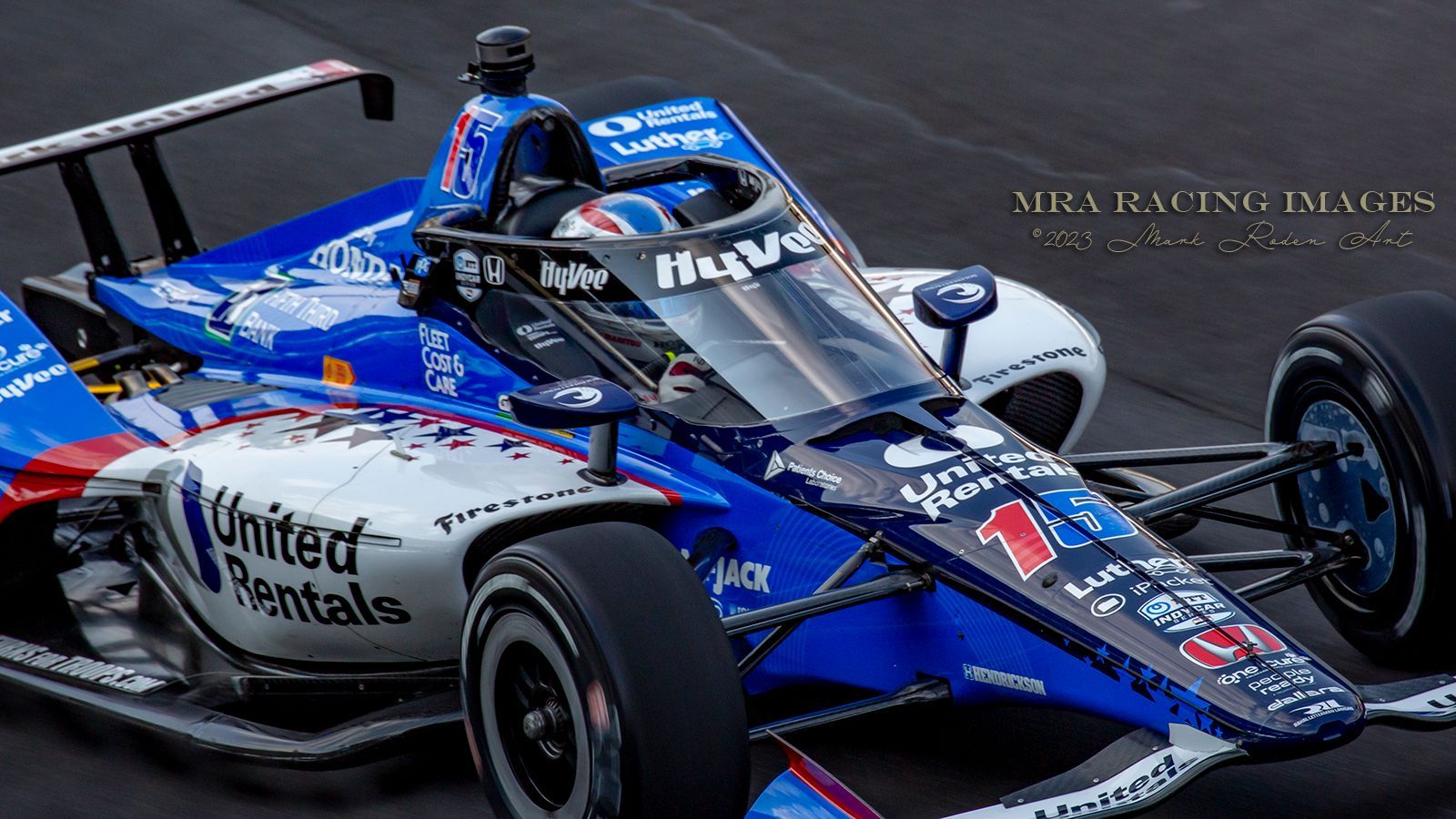
A notable record was that there were 84 attempts on day 1, the most of any year of the 500.
21 May, Sunday: Indy 500 Qualifying, Day 2
11:30AM-12:30PM EST PRACTICE-TOP 12
12:30PM-1:30PM EST PRACTICE-LAST CHANCE QUALIFIERS
Q2: 2PM-3PM EST TOP 12 QUALIFYING
4PM-5PM EST LAST CHANCE QUALIFYING
Q3: 5:15PM-5:45PM EST FIRESTONE FAST SIX QUALIFYING
Practice started at 11:30 but we did not arrive at the track until later. My first shots were at 2:17pm, just after Santino Ferrucci produced a scorching 233.911 4-lap average, good enough for pole temporarily.
Benjamin Pedersen looked fast in practice, doling out a 235.026mph single no-tow lap. When they told him about the speed, he replied, “That’s fast. Holy cow, that thing is a rocket ship right now.”
Once the top 12 qualifying started, it was clear we were going to see some high speeds. Ferrucci made it known that he was gunning for the pole position. Scott Dixon was trying to become the first ever to win it for 3 straight years. Benjamin Pedersen became the fastest rookie qualifier since Tony Stewart in 1996, with a 232.671mph average. That’s a rookie speed. At Indy. That’s fast.
Several others posted 233+ runs; O’Ward, Sato, TK, Dixon, VeeKay, Palou and Rossi all hit the mark and then some, with Veekay coming the closest to Ferrucci’s speed. Then, around 3 o’clock, Rosenqvist seemed to shoot out of a cannon and minted a 234.081 as Ferrucci looked on, faster even than last year’s pole set by Dixon.
The “Fast Six” was now set with Rosenqvist, Ferrucci, VeeKay, Palou, Dixon and Pato O’Ward to round it out. The winner of the fast six shootout will take the pole position for the race.
We were on our way out to turn 1 and made it over there just in time to see the fast 6. Jack Harvey had just bumped Rahal out of the field with a 229.166mph lap and last chance qualifying ended. Rahal was out.
The last order of the day is the run for the pole. O’Ward started the action with a 233.158, then Scott Dixon posted a 233.151. Neither is good enough to win pole. Alex Palou took to the track in his #10 Chip Ganassi Racing machine, 4 laps later, he would post a 234.217mph 4-lap average, overtaking Rosenqvist’s earlier run and taking provisional pole for the moment.
The last 3 qualifying attempts were put up by Rinus VeeKay, Santino Ferrucci and at last, Felix Rosenqvist with one final chance to get back on top. VeeKay narrowly missed the spot, just .006mph behind Palou. Rosenqvist hit a 234, but it was not enough, and so Alex Palou was the 2023 pole winner. The excitement in the grandstands was very thick; we all cheered after every run, and even though the last run was just short of the mark, it made for a great day of racing action, and the best qualifying action I had seen in a long time. Now the lead-up to race day would begin.
22 May, Monday: Indy 500 Practice, Day 5
FP7: 1PM-3PM EST PRACTICE
Mark Robertson covered the day on track and in the pits. Mark has had many years of experience covering races such as the Indy 500 and even shot for the Associated Press back in the 1980’s.
Credit Images ©2023 M. Robertson Photo
Practice was fairly uneventful until 48 minutes to go, when Katherine Legge plowed into the back of Stefan Wilson, taking out both cars in a big hit against the wall. The cars were beaten up, but the major worry concerned Wilson, who sustained injuries from the crash. Speeds were down in the 229mph range as could be expected as the boost was now downset to 1.3 bar, racing boost.
Stefan Wilson suffered a broken vertebrae and was not cleared to start the race. His car would be repaired, and none other than Graham Rahal, who had been bumped out of the race the day before, got tapped to fill the seat.
26 May, Friday: Indy 500 “Carb Day”, Practice Day 6.
FP8: 11AM-1PM EST PRACTICE
2:30PM-4PM EST INDY 500 PIT STOP CHALLENGE
Although I did not attend carb day this year, I will give you a brief run-down of the day’s events. The first thing after track opening is the last free practice. The term “carb day,” short for “carburetion day,” is a legacy term from the early days of racing describing a day that the teams would do last minute tuning of the carburetors in conditions similar to race day.
There have been no carbureted Indy cars since the early 1960’s, however the name and day have become a continuing tradition at the speedway.
28 May, Sunday: Indianapolis 500 Race Day.
One thing is for certain…you have to get up early on race day to get to the track on time. Once that traffic builds up (and we’re talking about 6:30-7AM local) you’re going to get stuck somewhere.
This year we entered from the north as our seats were in turn 3. Mark has owned these seats since 2016, and since I have been coming in the last few years, I have always parked and entered from the south. It seems to be more difficult to get out from the south than north, but getting in on Sunday morning is a fight from any direction.
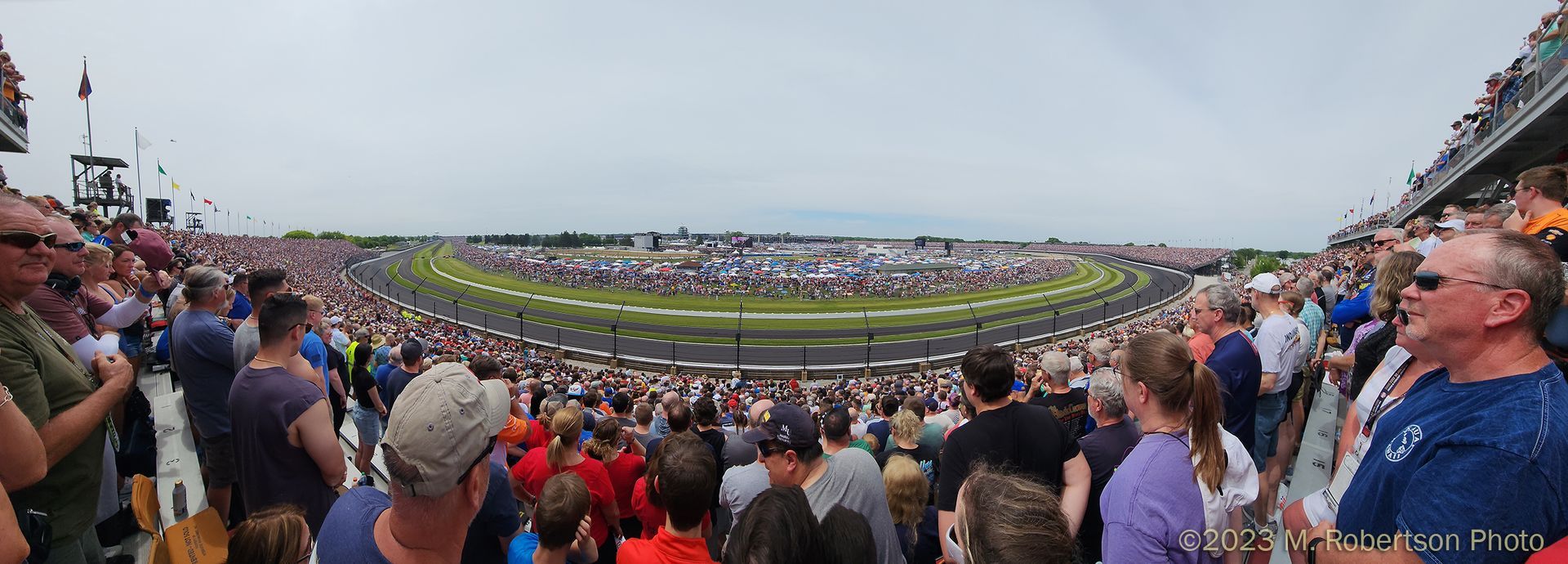
Credit Images ©2023 M. Robertson Photo
You start to feel the electricity in the air; something that I felt apparent from my very first race day back in 1985. Many of the traditions that I have become familiar with are still in use, even though they have a modern flair to them now. You will still hear “Back Home Again in Indiana,” taps, and see a fly-over by something with fixed wings.
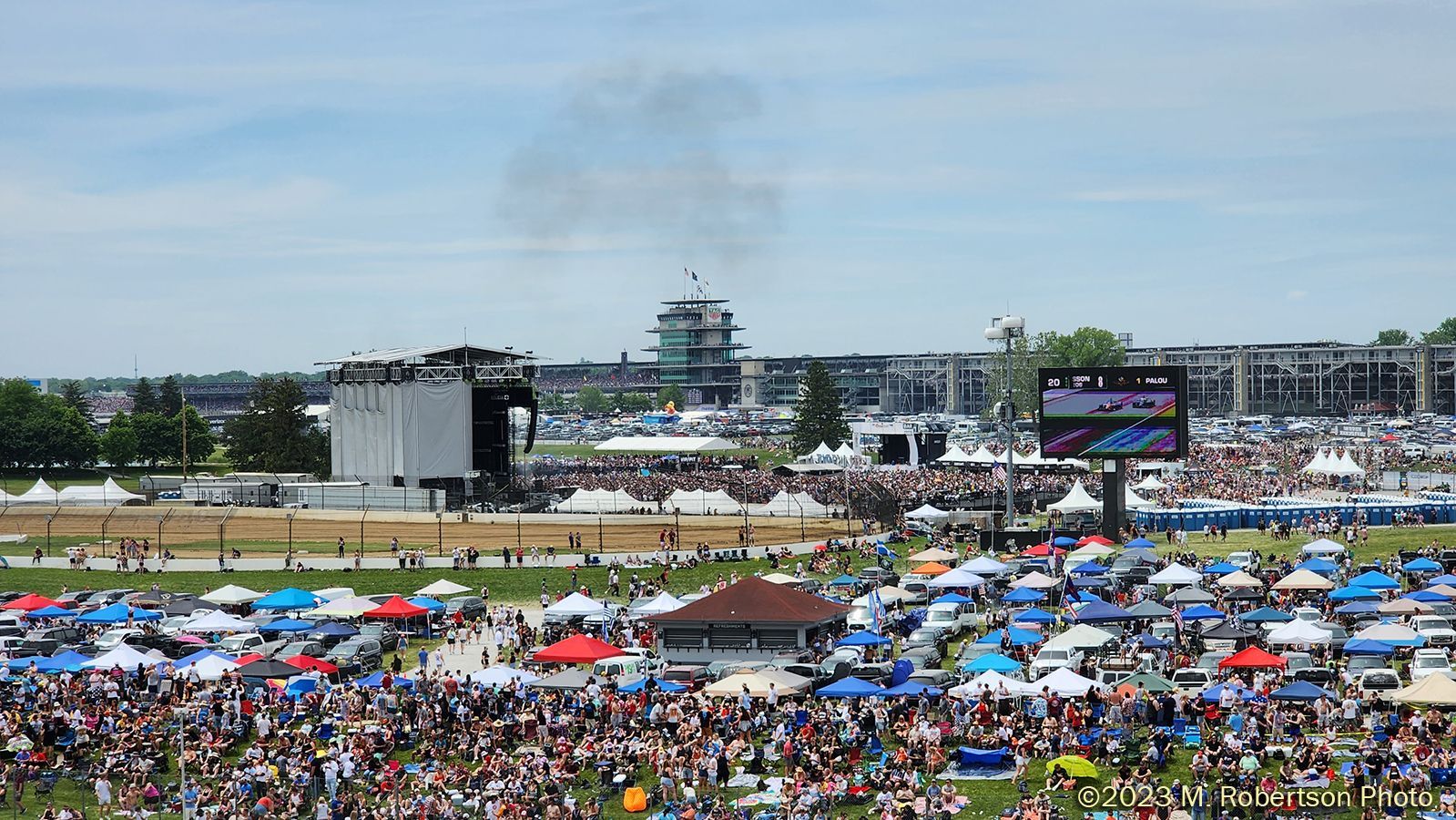
Credit Images ©2023 M. Robertson Photo
During the walk-in you are surrounded by thousands of other people, all making their way to seats in the grandstands, or concessions, or just standing around taking in the atmosphere. The immensity of the grandstands somehow becomes apparent after a month of taking them for absolute granted; these are formidable structures, not the folded metal bleachers set out for rugby games.
The view from our seats is very nice, and from that vantage point you can see most of the track. Turn 1 is not visible although grandstand B-E are, as is the back of the pagoda tower and the top half of the scoring pylon. We can clearly see turn 4, and the short chute. To the left you can see the entirety of the backstretch through turn 2 and much of the short chute between 1 and 2.
Directly across in the infield is what they call the “Snake Pit,” which is a modernized version of the original snake pit which was once located inside turn 1 and the short chute. Now, it has been moved to inside turn 3 and accompanied by a massive stage set up which supports an EDM music concert during the entire race. While cars are screaming by on the track, pyrotechnics and droning sounds emanate from the concert.
It’s not my thing, but it seems to be popular as there are many people in the “mosh pit.” One more tradition to keep up with, I guess.
Credit Images ©2023 M. Robertson Photo
The Race
Much has been said about this race over the years; about the history, the importance of it, the grandeur and sheer spectacle of it all. In fact, it is called “The Greatest Spectacle in Racing,” and for good reason. There is no other single day sporting event this grand and with anywhere near this level of attendance (at one point it boasted 400K, although I believe it is somewhere around 300K attendees this year.

As the race began, all of the hype and excitement surrounding it melted into exuberance as the green flag dropped. 200 laps, 500 miles to go. Palou led the field down for the green and maintained the lead through the first turn, followed closely by Rinus VeeKay and Felix Rosenqvist. As they came around to turn 3 where we were sitting you could see them already snaking down the backstretch. Scott Dixon started having problems immediately with a severe vibration. Katherine Legge spun in the pits around lap 35 and came close to hitting a crew member.
Credit Images ©2023 M. Robertson Photo
The first half of the race ran at a fever pace; so quick that I wondered if they would be setting a time record for shortest race. This, of course, would not hold up as it never does. Once they get past halfway, or 100 laps, it becomes an official race. This means that in any event, even in a shortened race, there will be a winner. Before lap 100, if the race is shortened for any reason (usually due to weather), they will postpone the finish until another day. This has happened on a number of occasions.
At near the halfway point, “Stingray” Robb was responsible for the first caution flag of the day by spinning and clipping the wall. A few laps later, VeeKay hit Palou when both were coming out of their pit boxes. So much for that record time.
Lap 100 saw a restart with 3-wide passing in the corners. It was obvious that everyone was turning up the wick and this was going to be a shootout similar to the Texas race earlier this year. Notably, Callum Ilott led the field to the restart. As far as I know, it was the first time that driver had ever led the 500, if only for a moment.

Credit Images ©2023 M. Robertson Photo
On lap 134 Colton Herta exited his pit box and contacted his teammate Romain Grosjean as he was coming into his box. With 66 laps left the tension was starting to become palatable. On track, there were passes every lap and the action was non-stop, except for the cautions to come.
Grosjean spun with no contact on lap 150. Six laps later on the restart Ericsson and Newgarden battled into the first turn while Santino Ferrucci vaulted from fifth place to third before hitting the end of the flat. By lap 160 he would be in the lead, mixing it up with the Ericsson/Newgarden duo.
Credit Images ©2023 M. Robertson Photo
With 16 laps to go, the most horrifying and potentially devastating wreck happened. Rosenqvist hit the wall, losing control, and spun back across the track. As Kyle Kirkwood approached, they made contact in such a way that the rear left wheel assembly was completely sheared off from the car.
As a result, it went flying up and over the retaining fence and narrowly missed the grandstands outside of turn 2. I did not see the tire flying even though it would have been in view had I been looking; I saw it only on the replay on the large video screens.
We began talking and asking about it and if anyone had noticed where it landed. Incredibly, the tire and wheel landed on a car in between turn 2 grandstand and the suites just past them. At 200 miles per hour, this is a narrow target to hit. Later, we were all very glad to see that only a car and a golf cart were damaged.
Meanwhile, as all of that was playing out, Kirkwood sped through turn 2 into the wall and continued onto the backstretch on his head. There was such a debris field that the red flag came out temporarily stopping the race while clean up could occur.

Credit Images ©2023 M. Robertson Photo
On the restart with 9 laps to go, Josef Newgarden took the lead from Ericsson going into turn 1 with Pato O’Ward just behind them. They continued around to turn 3 where we watched O’Ward duck down inside Ericsson and into the grass, trying to make a pass.

Credit Images ©2023 M. Robertson Photo
He was very low, and I was sure that he wouldn’t make it out of that one. He tried to pull back up, but the car became unstable and spun beside Ericsson’s car. This caused a secondary spin involving Simon Pagenaud and Agustin Canapino who hit a stationary O’Ward and came to a stop beside him. All of this caused a second red flag.
Credit Images ©2023 M. Robertson Photo
On the next restart, with 5 laps to go, the collisions began on the front straight before the green flag dropped. This is where some debate began about who should have been in the lead at that point. Newgarden and Ericsson were side-by-side at the line with a green flag waving. However, since the wreck happened before they got to the line, the questions centered around how they would re-order the field for the restart, and whether or not the race would finish under yellow. Pedersen, Rahal and Carpenter were all out as a result of the crash, and yet another red flag brought the action to a halt.
Racing continued with 2 laps to go, and the field hit the bricks as concurrent green and white flags waved above. Ericsson got the drop and took the lead into 1, kept it through 2, and then on the exit Newgarden made his race-winning move out front. He would hold the lead up to the line, after dipping very low and over the dashed pit lane indicator line (which was apparently legal as far as officials were concerned), taking the checkered flag and winning his first Indianapolis 500 after twelve years of trying.
Credit Images ©2023 M. Robertson Photo
On the cool-down lap, he parked directly on the yard of bricks at the start/finish line, got out of the car and ducked through a hole in the catch fence making his way into a sea of spectators. I have it on good authority that this is the first time any Indy 500 winning driver has ever done this.
Congratulations, Josef Newgarden.
You can share this report with your friends on Social Media using these links.



